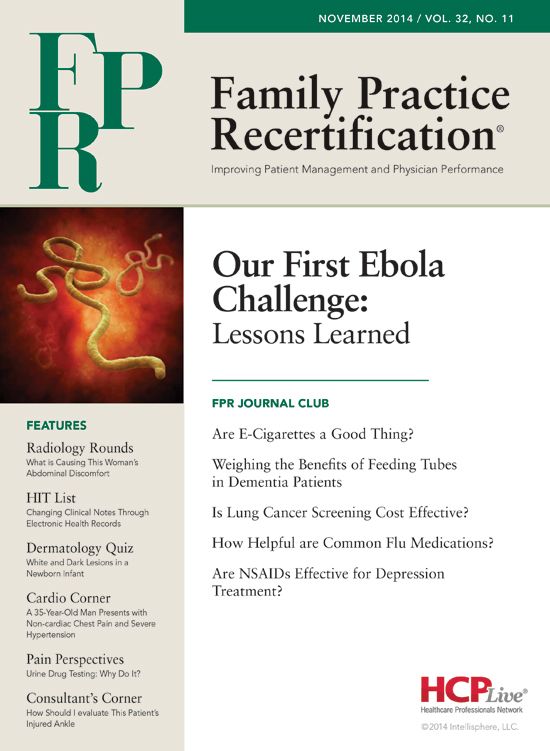Publication
Article
How Should I Evaluate This Patient's Injured Ankle?
Author(s):
A 28 year-old commercial realtor comes to your office on Monday morning after spraining his right ankle in a basketball game with friends the preceding Saturday afternoon. He has a swollen right ankle with tenderness inferior and anterior to the lateral malleolus. He is limping but able to apply weight to the injured extremity.
A 28 year-old commercial realtor comes to your office on Monday morning after spraining his right ankle in a basketball game with friends the preceding Saturday afternoon. He immediately applied ice to the ankle and has kept it elevated over the weekend in addition to applying ice several times on Sunday. He says he came down from grabbing a rebound and landed on an opposing player’s foot, turning his ankle and experiencing immediate pain. He has a swollen right ankle with tenderness inferior and anterior to the lateral malleolus. He is limping but able to apply weight to the injured extremity. The anterior drawer test reveals mild anterior displacement of the talus with a firm endpoint. The external rotation test does not cause significant pain in the syndesmosis and the squeeze test is negative.
How does the history help with the diagnosis?
The patient describes an isolated inversion injury of his ankle with immediate pain which leads you to suspect injury to the lateral ankle structures. He was appropriately using ice and elevation but additional history questions should include: Did you experience immediate swelling of the ankle? Was there a pop or snap felt? Were you able to walk on the ankle after the injury? Do you have knee or foot pain? Have you injured this ankle before? Does the ankle feel unstable? Any numbness or tingling in the foot?
What other injuries should be considered in the differential diagnosis?
Although low ankle sprains (injuries to the anterior talofibular ligament (ATFL) and calcaneofibular ligament (CFL) are the most common ankle sprains (90%), syndesmotic injuries (high ankle sprains) should also be on your differential.
A variety of ankle fractures including fractures of the lateral malleolus (distal fibula), base of the 5th metatarsal, anterior process of the calcaneus, lateral or posterior process of the talus and medial malleolus (distal tibia) should be considered. Peroneal tendon injuries, deltoid ligament injuries and osteochondral defects (most commonly on the talar dome) should also be included in your differential.
How does the physical examination assess the severity of injury?
Low ankle sprains can be classified as Grades 1, 2 and 3, with Grade 3 being the most severe. Typically Grade 1 sprains are characterized by minimal swelling and no significant pain with weight bearing. Grade 2 sprains have moderate swelling and mild pain weight bearing and Grade 3 sprains are severe both in swelling and pain.
In the acute setting it can sometimes be difficult to assess the amount of laxity and translation of the joint on anterior drawer testing due to swelling and pain, but typically with Grade 1 sprains there is minimal translation with a firm endpoint. A Grade 2 sprain will have increased translation with a firm endpoint and a Grade 3 sprain will have increased translation with no firm endpoint. It is most useful and important to compare to the opposite side, assuming no history of prior trauma to the contralateral ankle, as many people have baseline mild laxity in the ankle joint (however there should always be a firm endpoint).
The external rotation stress test can help to assess for a syndesmotic injury, or a “high ankle” sprain. This is performed by dorsiflexing the ankle and applying an external rotation force to the tibial talar joint with the knee and hip flexed to 90 degrees. Pain with this maneuver should increase your concern for a syndesmotic injury. The squeeze test can also be used to assess for a high ankle sprain. A squeeze test is positive if compression of the tibia and fibula at the midcalf level causes pain at the syndesmosis.
To complete your physical exam, always remember to examine the joints above and below the injury, specifically palpation of the proximal fibular head with any ankle injuries.
Our patient has moderate swelling, mild pain weight bearing and increased laxity on anterior drawer testing but a firm endpoint, all pointing towards a Grade 2 low ankle sprain with tenderness over the ATFL and CFL.
Does this patient need x-ray films?
The Ottawa Ankle Rules are a well validated decision making tool useful in the acute setting of adult ankle injuries. Using these guidelines, X-rays are indicated only if there is inability to bear weight or bony tenderness at any of four sights in the ankle: the posterior edge or tip of the medial malleolus, the posterior edge or tip of the lateral malleolus, the base of the fifth MT, or the navicular. With further examination, our patient does not demonstrate any bony tenderness in these areas (he is tender inferior and anterior to the lateral malleolus, not on the bone or posterior) and although uncomfortable, he is able to bear weight. X-rays are not indicated in our patient.
What are the critical elements in managing the acutely sprained ankle?
In the acute setting, all suspected ankle sprains should be managed with RICE (rest, ice, compression, elevation). Our patient is already on the road to recovery as he has been resting, elevating and icing over the weekend. If the patient is unable to bear weight comfortably, a short period of weight bearing immobilization in a walking boot or cast should be used to allow for comfortable weight bearing, however early mobilization is found to facilitate faster recovery so daily range of motion (ROM) should be recommended even while immobilized. An ankle brace can also be useful in lower grade sprains and as a transition out of a boot or cast to allow for protected weight bearing during the recovery period.
Physical therapy can be started immediately to help decrease swelling and increase ROM. Once the swelling has subsided and full range of motion is achieved, neuromuscular training including strength and proprioception can begin. As the patient returns to their activities, a functional brace can be helpful to provide some stability through compression and biofeedback.
.
If formal physical therapy is not available or an option for the patient, how would you instruct the patient?
If your patient is unable to attend formal physical therapy, you should instruct them to start to work on their range of motion (ROM) as soon as possible. Two simple instructions can include: spelling the alphabet with their ankle and simple non-weight bearing dorsiflexion and plantarflexion (“point and flex the foot”).
When the swelling has decreased and the ROM has increased, they can begin to strengthen using a towel for resistance in different planes of motion while sitting. Finally, they should work on balance and strength by doing double and single toe raises (with support to prevent falls) and a simple single leg stance, first on the floor and then on a towel, which challenges the ankle in proprioception.
.
What about a patient with chronic ankle pain after treatment for an acute injury?
After recovery from an acute ankle injury, up to 50% of patients continue to experience symptoms of pain and instability. Most cases of chronic ankle pain and instability can be treated with a proper course of physical therapy however it is important to rule out a missed injury. The most common missed injuries around the ankle joint include: injury to the base of the 5th metatarsal, injury to the anterior process of the calcaneus, injury to the lateral or posterior process of the talus, an osteochondral lesion, injury to the peroneal tendons, a syndesmotic injury, tarsal coalition or impingement syndromes which can be both bony or soft tissue in origin. A repeat thorough history and physical exam can often determine the cause for continued pain, but further imaging including plain radiographs or MRI may also be required.
Can ankle injuries be prevented?
The best prevention for ankle injuries is proper physical therapy, specifically strength and neuromuscular training. As an athlete gains increased strength and proprioception and is returning to activities, functional ankle braces can be useful for prevention of recurrent injuries as they provide stability and biofeedback however they cannot substitute for proper rehab.
About the Author

Dr. Gillespie is an associate professor of Clinical family medicine at the David Geffen School of Medicine at UCLA. She also serves as the team physician for the UCLA Intercollegiate Athletics program.






